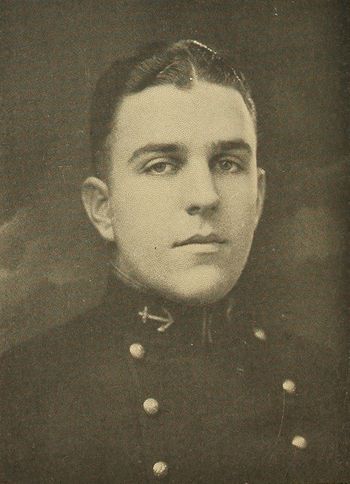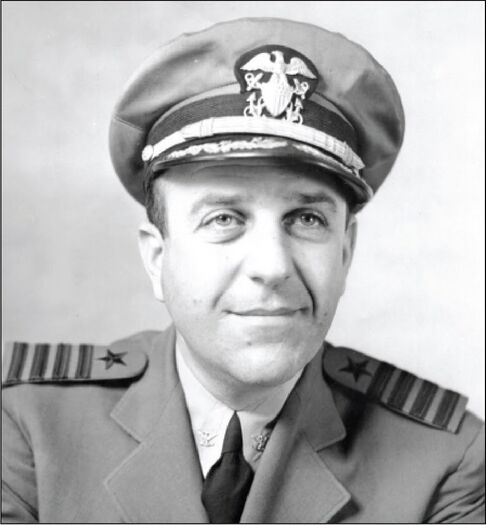EUGENE S. KARPE, CAPT, USN
Eugene Karpe '26
Lucky Bag
From the 1926 Lucky Bag:
Eugene Simon Karpe
Delhi, Louisiana
"Fish"
A NATURAL born Snake with the instincts of a Red Mike. Can you imagine a man so hardened to the charms of women that he was filled with ennui when a charming blind drag joined the throng of victims and wrote him ten specials in the ensuing five days? Can you picture one to whom the light that lies in woman's eyes holds no charm? If you can, then can you see our Gene: His even features, his flashing eyes, his heart- ensnaring smile, are but a mask that covers a heart of stone.
Not a savoir and still he is not wooden (in the ways of life). We do not predict, however, that "The Society of American Electrical Engineers" will consult him on any of their more weighty problems. Nevertheless, he shows wisdom beyond his years.
Coming to our midst from the Sunny Southland, he followed its traditions by picking a lazy man's sport. Every afternoon during the "lazy daisy" days found him among Chief Bender's cohorts of the diamond.
In conclusion, let us ask, What's wrong with this picture? The only answer is, "nothing"; for even the daily mails have been choked by tributes to his charm.
Class Baseball (4); Baseball Squad (3, 2, 1), ANA (3); Reception Committee (2, 1); Class Football (4, 1).

Eugene Simon Karpe
Delhi, Louisiana
"Fish"
A NATURAL born Snake with the instincts of a Red Mike. Can you imagine a man so hardened to the charms of women that he was filled with ennui when a charming blind drag joined the throng of victims and wrote him ten specials in the ensuing five days? Can you picture one to whom the light that lies in woman's eyes holds no charm? If you can, then can you see our Gene: His even features, his flashing eyes, his heart- ensnaring smile, are but a mask that covers a heart of stone.
Not a savoir and still he is not wooden (in the ways of life). We do not predict, however, that "The Society of American Electrical Engineers" will consult him on any of their more weighty problems. Nevertheless, he shows wisdom beyond his years.
Coming to our midst from the Sunny Southland, he followed its traditions by picking a lazy man's sport. Every afternoon during the "lazy daisy" days found him among Chief Bender's cohorts of the diamond.
In conclusion, let us ask, What's wrong with this picture? The only answer is, "nothing"; for even the daily mails have been choked by tributes to his charm.
Class Baseball (4); Baseball Squad (3, 2, 1), ANA (3); Reception Committee (2, 1); Class Football (4, 1).
Loss
Eugene died on February 23, 1950 when he was pushed from a train south of Salzburg, Austria. He was en route to the United States for reassignment after serving as a naval attaché in Romania.
From the Boston Globe on February 6, 1952:
BERNE, Switzerland, Feb, (Reuters) Ryan Parescu, 25, Romanian, has confessed he helped push Capt Eugene Karpe, American naval attaché to Romania, to his death from an Austrian train, Swiss Federal police said today, Parescu, arrested here last month in connection with the two-year-old mystery which has shrouded Karpe's death, said, "The crime was committed on orders from a foreign organization," the police said.
Karpe's mutilated body was found Feb. 23, 1950, in the Lueg Pass tunnel 12 miles south of Salzburg, Austria, He was traveling between Bucharest and Paris on the Arlberg express when he was missed.
International police have puzzled since whether the tall, heavily-built bachelor's death was an accident or murder. The 45-year-old, wartime destroyer commander, representing America for 18 months in Bucharest, was reported to have a wide knowledge of Russian affairs, especially about Russia's Black Sea and Danube River fleets.
The police statement said Parescu confessed "with the aid of two accomplices he pushed Capt Karpe from the train after stealing important documents in his possession."
Visited Vogeler's Wife
In the course of the journey, Karpe had stayed over in Vienna a few days and visited the blonde Belgian wife of his friend, Robert Vogeler, American businessman sentenced a few days before in Budapest to 13 years in jail for spying and sabotage.After Karpe's body was found, Mrs. Vogeler told a reporter she had a mysterious telephone call warning her to let the fate of "your friend be a lesson for you."
Russel McMichan, American student who was the last person seen with the diplomat, was later reported to have locked himself in his cabin aboard the Queen Mary as he sailed home after stating he was afraid for his life.
Photographs
Remembrance
Robert Vogeler was close friends with Eugene; Getty Images has a picture of them together. Robert was once a Naval Academy midshipman (Class of 1933), though he resigned in December 1931. He and Eugene met in March 1947, after Eugene had been stationed in Europe.
From Dangerous Games:
The rumor that Karpe was drunk and had fallen out of his compartment as the Arlberg Express went through the tunnel was a libel. He was not drinking at the time, because of gout, and he was completely sober in the dining car before his death. The CIC [Counter-Intelligence Corps, Vienna] experimented with sandbags of the same weight as Karpe (200 pounds) and thus confirmed, beyond any possibility of doubt, that he had been thrown from his compartment. His body caromed off the side of the tunnel and fell beneath the wheels of the train. In order to achieve the same result with a sandbag, it was necessary for two CIC agents to hurl it out of a similar compartment with all the force at their command.
Fish Karpe was a fun-loving bachelor who had enjoyed considerable success as a ladies' man. He had often traveled between Bucharest and Vienna on the Orient section of the Arlberg Express and he told Lucile Vogeler that on several trips he had met the same Hungarian blonde. He had met her again on his last trip to Vienna, and as usual she was on her way to Paris. Fish had made a date to meet her there on his way through to Washington. It was impossible, given the AVH's [Hungarian State Defense Authority] passport regulations, for anyone, even an attractive blonde, to travel repeatedly between Paris and Budapest except on official business. Fish had evidently been hoping to learn what her official business was.
Other Information
From researcher Kathy Franz:
In 1935 Eugene married Engracia Freyer (daughter of Captain Frank Freyer '02), but by 1940 she was again using her maiden name on voyages. Eugene's father was also Eugene, an employee in a general merchant store. His mother was Clara, and he had two sisters and two brothers.
He is buried in Arlington National Cemetery.
Wartime Service
Eugene had command of USS Whipple (DD 217) at the beginning of the war; Whipple was based in Manila.
Loss of USS Langley (AV 3)
USS Langley (AV 3) was attacked and sunk on February 27; Eugene was mentioned by name by the commanding officer of Langley in his post-sinking report:
The Commander of Destroyer Division FIFTY-SEVEN, Commander E.M. Crouch, USN; the Commanding Officer of the U.S.S. WHIPPLE, Lieut-Commander E.S. Karpe, USN, and the Commanding officer of the U.S.S. EDSALL, Lieutenant J.J, Nix, USN, deserve great credit for their skill and daring in maneuvering their vessels, prior to, during and after the action, in screening and in effecting the rescue of the LANGLEY survivors. The remarkable high percentage of effectiveness in rescuing the wounded is due to the preparedness and to the effective ship handling on the part of the destroyer captains. A careful check of survivors at this time showed a maximum of six (6) killed and five (5) missing.
From a (now-private) post the Java campaign at https://www.tapatalk.com/groups/TheOvervalwagenForum/a-few-more-bits-on-usn-officers-in-java-campaign-t1919.html:
The final decision wherein USS Whipple (DD 217) departed the area after rescuing a number of the survivors from Pecos (AO 6) and Langley (AV 3), but leaving behind approximately 2/3 of the intermingled survivors, including previously wounded men from Houston (CA 30), Marblehead (CL 12), and Stewart (DD 224), was of course that of her captain, Lt. Cmdr. Eugene Karpe. But aboard were three USN officers who outranked him, Commanders E. Paul Abernathy (Pecos), Robert McConnell (Langley), and Edwin M. Crouch (ComDesDiv 57), who was Karpe's boss. The men in the water were those commanded by Abernathy and McConnell, who must have been reluctant to leave the survivors behind. One must remember the danger the destroyer was in: she was already overloaded with survivors, Japanese aircraft were almost certain to return the next day to finish the job, and there was more than one submarine warning during the night of the rescue. Fairly or unfairly, however, in the eyes of many, Crouch took a hefty share of the blame for Whipple's failure to hang around on the following morning.
For the sake of completeness and in way of reminder, USS Pecos (AO 6) was sunk in the Indian Ocean at around 3:30 p.m., March 1, 1942, by attacking aircraft launched from all four of the IJN carriers that would be lost three months later at Midway. USS Whipple (DD 217) arrived on the scene at 7:15 p.m. and began rescuing survivors shortly thereafter. After at least two alerts of submarines close aboard, thereupon leaving the area and returning for a brief resumption of rescue operations, Whipple cleared the area permanently a few minutes after 10 p.m., same date. [Details from Dwight R. Messimer, Pawns of War, 1983]
Legion of Merit
From Hall of Valor:
(Citation Needed) - SYNOPSIS: Captain Eugene S. Karpe, United States Navy, was awarded the Legion of Merit for exceptionally meritorious conduct in the performance of outstanding services to the Government of the United States as Commanding Officer of a United States Navy Destroyer in the Pacific Ocean Area during World War II.
General Orders: Bureau of Naval Personnel Information Bulletin No. 364 (June 1947)
Service: Navy
Rank: Captain
The "Register of Commissioned and Warrant Officers of the United States Navy and Marine Corps" was published annually from 1815 through at least the 1970s; it provided rank, command or station, and occasionally billet until the beginning of World War II when command/station was no longer included. Scanned copies were reviewed and data entered from the mid-1840s through 1922, when more-frequent Navy Directories were available.
The Navy Directory was a publication that provided information on the command, billet, and rank of every active and retired naval officer. Single editions have been found online from January 1915 and March 1918, and then from three to six editions per year from 1923 through 1940; the final edition is from April 1941.
The entries in both series of documents are sometimes cryptic and confusing. They are often inconsistent, even within an edition, with the name of commands; this is especially true for aviation squadrons in the 1920s and early 1930s.
Alumni listed at the same command may or may not have had significant interactions; they could have shared a stateroom or workspace, stood many hours of watch together, or, especially at the larger commands, they might not have known each other at all. The information provides the opportunity to draw connections that are otherwise invisible, though, and gives a fuller view of the professional experiences of these alumni in Memorial Hall.
October 1926
January 1927
April 1927
October 1927
January 1928
April 1928
July 1928
LTjg Robert Larson '24 (Scouting Plane Squadron (VS) 3B)
October 1928
January 1929
LTjg Matthias Marple, Jr. '23 (Fighting Plane Squadron (VF) 3B)
April 1929
LTjg Matthias Marple, Jr. '23 (Fighting Plane Squadron (VF) 3B)
LTjg Jack DeShazo '25 (Light Bombing Plane Squadron (VB) 1B)
July 1929
October 1929
January 1930
April 1930
October 1930
January 1931
April 1931
July 1931
October 1931
January 1932
April 1932
October 1932
January 1933
April 1933
July 1933
LCDR Lyman Swenson '16
LCDR Charles Cecil '16
LT Robert Smith '20
LT Paul Register '21
LT George Brooke '21
LT Howard Healy '22
1LT Charles Kail '23
LT Hallsted Hopping '24
LTjg Lawrence McPeake '24
LTjg James Smith, Jr. '25
October 1933
LCDR Lyman Swenson '16
LCDR Charles Cecil '16
LT Robert Smith '20
LT Paul Register '21
LT George Brooke '21
LT Howard Healy '22
1LT Charles Kail '23
LT Hallsted Hopping '24
LTjg Lawrence McPeake '24
LTjg William Graham, Jr. '25
LTjg Andrew Harris '25
April 1934
LCDR Lyman Swenson '16
LCDR Charles Cecil '16
LT Robert Smith '20
LT Paul Register '21
LT William Gray '21
LT George Brooke '21
LT Howard Healy '22
1LT Charles Kail '23
LT Hallsted Hopping '24
LT Lawrence McPeake '24
LTjg William Graham, Jr. '25
July 1934
LCDR Albert Rooks '14
LCDR Charles Cecil '16
LT Paul Register '21
LT William Gray '21
LT George Brooke '21
LT Howard Healy '22
LT Edward Metcalfe '22
LT Eugene Elmore '22
1LT Charles Kail '23
LTjg William Graham, Jr. '25
October 1934
January 1935
April 1935
October 1935
January 1936
April 1936
July 1936
January 1937
April 1937
September 1937
January 1938
July 1938
January 1939
October 1939
June 1940
November 1940
April 1941
Memorial Hall Error
Other alumni in Memorial Hall have been assassinated, and one of them (Albert Schaufelberger, III '71 is listed on the killed in action board in Memorial Hall. It seems that Eugene should be so listed as well; he was killed by a foreign power and his death was in no way related to training or other military operations.
Eugene is one of 33 members of the Class of 1926 on Virtual Memorial Hall.

The "category" links below lead to lists of related Honorees; use them to explore further the service and sacrifice of alumni in Memorial Hall.
